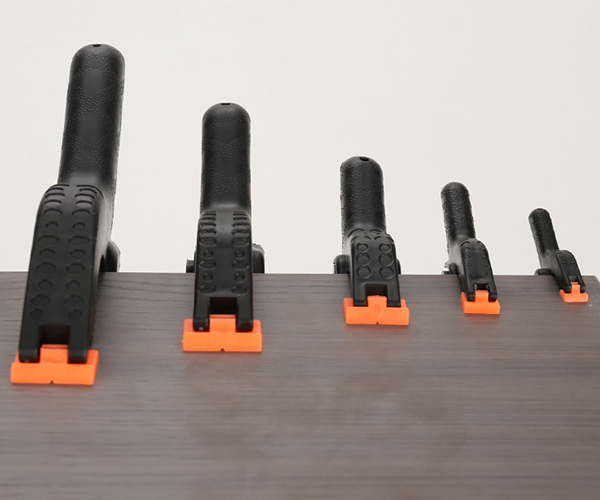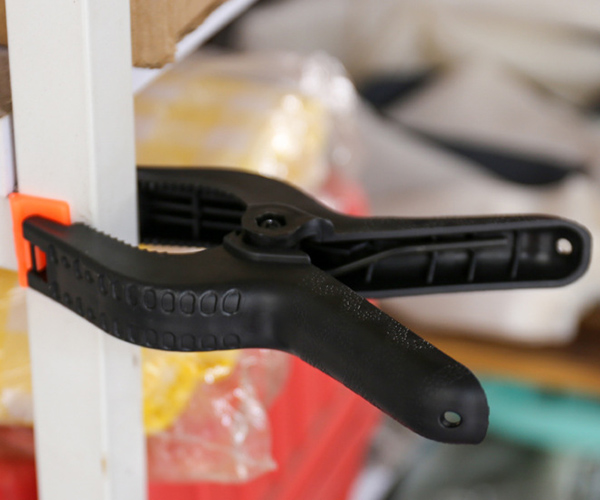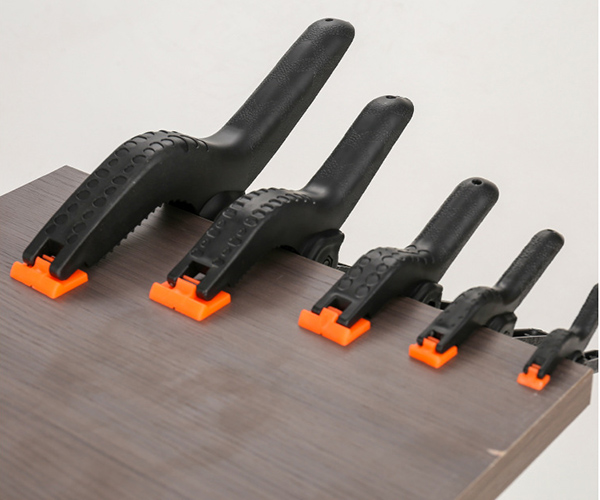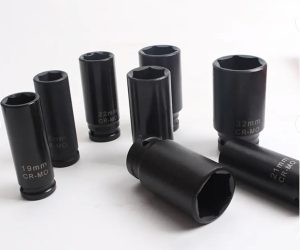Spring clamps are indispensable tools in woodworking, offering a fast, reliable, and easy way to hold materials in place during work. They’re typically used for clamping two objects together with the force of a spring, making them an ideal choice for woodworkers who need to secure pieces quickly and efficiently. In this article, we’ll explore everything there is to know about spring clamps – from their definition to their various applications in woodworking.
But here’s the kicker: despite their simplicity, spring clamps pack a punch in terms of versatility and utility. So, let’s break it down and look at what makes these little tools so essential in the workshop.
1. What is a Spring Clamp?
A spring clamp is a type of tool that uses the tension of a spring to hold materials in place. It has two arms that open when the spring is compressed and close when the tension is released, clamping down on the materials being held. The primary advantage of a spring clamp is its quick application, allowing users to secure materials without needing a lot of force.
Spring clamps are typically made from steel or plastic, depending on their intended use. They come in various sizes, with each size serving a specific purpose. For example, smaller spring clamps are ideal for delicate tasks that require a light grip, while larger clamps can hold bigger pieces of wood or thicker materials.
What’s the real story? While they may look like simple tools, spring clamps have evolved over the years to become highly durable and reliable. Some even come with rubber tips to prevent damage to sensitive materials.
Now, let’s dive into the different types of spring clamps and their applications.
| Type of Spring Clamp | Best For | Material | Grip Strength |
|---|---|---|---|
| Small Spring Clamp | Delicate materials | Plastic | Light |
| Medium Spring Clamp | General woodworking | Steel | Medium |
| Large Spring Clamp | Large workpieces | Steel | Strong |
2. Why is a Spring Clamp Essential for Woodworking?
Spring clamps are widely used in woodworking because they offer multiple benefits that improve the overall quality of projects. The importance of precision in woodworking cannot be overstated, and spring clamps play a crucial role in achieving that precision.
Ready for the good part? One of the key reasons these clamps are so useful in woodworking is that they allow for quick, hands-free operations. For example, when you’re working on detailed cuts or assembly, having a clamp hold materials in place frees up both hands for other tasks, such as using power tools or sanding.
Additionally, spring clamps provide consistency. Whether you are clamping together two pieces of wood or holding a piece of fabric in place, the pressure applied by the clamp remains even, which is crucial for accurate cuts and joints.
But here’s where it gets interesting: these clamps also promote safety in the workshop. By securely holding materials, they prevent slippage, reducing the risk of injury during work. This makes spring clamps a go-to choice for both professionals and hobbyists alike.
| Benefit | Details |
|---|---|
| Quick Setup | Allows for fast and efficient clamping without needing a lot of force. |
| Hands-Free Operation | Frees up both hands for other tasks during work. |
| Consistent Pressure | Provides even pressure, improving precision and results. |
| Safety | Reduces the risk of slipping, keeping fingers away from sharp tools. |

3. What Are the Different Types of Spring Clamps?
There are a few different types of spring clamps available, each designed to cater to specific tasks. Understanding these options allows woodworkers to select the right clamp for their needs, whether they’re dealing with small, delicate projects or large-scale builds.
So, how do they differ? Smaller spring clamps are ideal for light tasks like holding small pieces of wood together for sanding or gluing. They are lightweight and easy to maneuver in tight spaces, making them great for detail work.
On the other hand, larger spring clamps are used for heavy-duty tasks, such as clamping large sheets of plywood or MDF. These clamps have stronger springs, providing a firmer grip for bigger and thicker materials.
Additionally, specialty spring clamps exist for specific applications, like those with wide jaws for clamping over larger surfaces. Some spring clamps even have padded tips to protect delicate surfaces or prevent damage during clamping.
| Type of Spring Clamp | Primary Use | Maximum Grip | Material |
|---|---|---|---|
| Small Clamp | Detail work | Light | Plastic |
| Medium Clamp | General use | Medium | Steel |
| Large Clamp | Heavy-duty tasks | Strong | Steel |
| Specialty Clamp | Wide or delicate surfaces | Varies | Steel, Rubber |
4. How Does a Spring Clamp Work?
Spring clamps work by using the tension of a spring mechanism to apply pressure. The two arms of the clamp are held apart by the spring tension. When you compress the arms, the spring contracts, creating a tight hold on whatever you’re clamping.
What’s the catch? The effectiveness of a spring clamp depends on the spring’s strength and the size of the clamp. The larger the clamp, the stronger the spring, and the more pressure it can apply to the materials. This design allows for quick adjustments, ensuring the clamp is versatile enough for a wide range of uses.
So, how does this help woodworkers? A strong, reliable spring clamp makes it easy to hold materials in place for extended periods without having to constantly readjust or apply extra force. This frees up more time for other important tasks, like cutting or sanding.
| Feature | Details | Effect |
|---|---|---|
| Spring Tension | Varies based on clamp size | Creates pressure |
| Clamp Size | Small, Medium, or Large | Affects strength |
| Grip Pressure | Even pressure applied throughout | Increases precision |
5. How Do You Use a Spring Clamp in Woodworking?
Using a spring clamp in woodworking is as simple as it gets. Here’s a quick guide to get you started:
- Open the clamp: Squeeze the arms together to compress the spring, opening the clamp.
- Position the clamp: Place the clamp around the workpiece, ensuring that the tips are aligned where you want the pressure.
- Release the spring: Let go of the arms, allowing the spring to close the clamp and apply pressure.
But here’s the kicker: while using a spring clamp may seem straightforward, it’s important to know how to apply the correct amount of pressure. Too much pressure can cause damage to delicate materials, while too little pressure will result in a weak hold.
For best results, make sure the clamp is fully engaged before starting your work. Also, avoid overloading the spring by using a clamp that’s too small for your materials. This will ensure that the pressure is evenly distributed and your work stays in place.
| Step | Action | Result |
|---|---|---|
| Open the Clamp | Squeeze the arms together | Clamp opens |
| Position the Clamp | Place around the material to clamp | Align clamp tips |
| Release the Spring | Let go of the arms and apply pressure | Hold materials firm |
6. What Are the Benefits of Using a Spring Clamp in DIY Projects?
Spring clamps are a staple in DIY woodworking for several reasons. These benefits extend beyond just convenience and can significantly enhance your project’s quality.
What’s the real story? The biggest advantage is time savings. DIY projects often involve multiple steps, and using a spring clamp allows you to move quickly between tasks without needing to pause to re-secure materials. This keeps projects on track and reduces overall build time.
Additionally, spring clamps are easy to use, making them ideal for beginners or anyone looking to simplify their projects. There’s no complicated setup – just a quick squeeze, and you’re good to go.
But it doesn’t stop there: spring clamps are versatile. They can be used not just in woodworking, but for a range of DIY projects, from crafting to home repairs.
| Benefit | Explanation |
|---|---|
| Time-saving | Quick application saves time in DIY projects |
| Ease of use | Simple design makes it easy for beginners |
| Versatility | Can be used for various materials and projects |
7. Can You Use a Spring Clamp for Metalworking?
Spring clamps aren’t just for woodworking. They can also be used in metalworking tasks, offering similar benefits. The primary difference is that metalworking often requires stronger clamps due to the materials involved.
Ready for the good part? When working with metal, you’ll need to select a spring clamp that’s made of strong steel. The increased grip strength is essential for securely holding metal pieces in place during tasks like welding or cutting.
Additionally, spring clamps can be used for tasks like holding metal pieces while drilling, giving you a steady, controlled environment in which to work. They’re also a great option for holding metal sheets together when working on larger metal fabrication projects.
| Use in Metalworking | Details | Material Needed |
|---|---|---|
| Holding Metal Sheets | Secures pieces during cutting/drilling | Steel clamp |
| Welding Support | Keeps metal parts steady while welding | Heavy-duty clamp |
| Fabrication Tasks | Holds large metal pieces together | Steel with strong spring |

8. How Do Spring Clamps Compare to Other Clamps?
Spring clamps are often compared to other types of clamps like C-clamps and bar clamps. While they may not be as strong as C-clamps, they excel in speed and convenience.
This is where it gets interesting: the key difference is in the clamp’s function. While C-clamps provide more significant pressure for holding thick materials, spring clamps are perfect for smaller, more delicate jobs. They’re designed for quick, repetitive tasks rather than heavy-duty work.
Additionally, spring clamps are more portable and easier to adjust than bar clamps, making them the ideal choice for DIYers and professionals who need a clamp that works fast and doesn’t require a lot of effort.
| Clamp Type | Strength | Best Use |
|---|---|---|
| Spring Clamp | Medium | Quick, light tasks |
| C-Clamp | High | Heavy-duty, precision work |
| Bar Clamp | High | Clamping larger surfaces |
9. What Materials Are Best for Spring Clamps?
Spring clamps come in a variety of materials, each offering its own benefits. The most common materials for spring clamps are steel, plastic, and aluminum.
What’s the deal? Steel clamps are the most durable and can withstand a lot of pressure, making them ideal for heavy-duty tasks. Aluminum clamps are lighter but still offer a reasonable level of strength, making them useful for general-purpose work. Plastic clamps, while not as strong, are typically used for lighter tasks and are a good option for those on a budget.
Choosing the right material depends on the task at hand. For instance, if you’re working with thick materials, steel clamps are your best bet. However, for lighter DIY projects, plastic clamps may be more than sufficient.
| Material | Best For | Durability |
|---|---|---|
| Steel | Heavy-duty tasks | Very High |
| Aluminum | General use | High |
| Plastic | Light tasks | Moderate |
10. How Do You Maintain a Spring Clamp?
To get the most out of your spring clamp, proper maintenance is essential. Cleaning, lubrication, and safe storage can all help extend the life of your clamp and ensure it continues to perform at its best.
But here’s the kicker: start by regularly cleaning your spring clamp to remove any dust, debris, or glue buildup. This ensures smooth operation and prevents the clamp from jamming or losing tension.
Next, apply a small amount of lubricant to the spring mechanism. This will help the clamp open and close with ease, reducing wear and tear. Finally, store your spring clamps in a dry place to prevent rust and damage from exposure to moisture.
| Maintenance Step | Action | Reason |
|---|---|---|
| Cleaning | Wipe off dust and debris | Prevents jamming |
| Lubricating | Apply light lubricant to spring | Ensures smooth operation |
| Storing | Keep clamps dry and stored safely | Prevents rusting |
11. What Are the Key Features to Look for in a Spring Clamp?
When purchasing a spring clamp, several key features should be considered. These include grip strength, material quality, and size. Depending on your specific needs, you might prioritize one feature over the others.
What’s the real story here? If you need a clamp for heavy-duty work, then size and strength should be your top priorities. A larger clamp with a stronger spring can apply more pressure, making it ideal for thicker materials.
However, for detailed work, you may prefer a smaller clamp with a more precise grip. Additionally, the quality of the material matters. Steel clamps tend to last longer and provide better grip than plastic ones.
| Feature | What to Look For | Why It Matters |
|---|---|---|
| Grip Strength | Stronger springs for larger clamps | Provides secure hold |
| Material Quality | Steel for durability, plastic for lightness | Longer lifespan |
| Size | Larger for heavy-duty, smaller for detail work | Affects versatility |
12. Where Can You Buy a Spring Clamp?
Spring clamps are available at most hardware stores and online retailers. Popular platforms like Amazon, Home Depot, and Alibaba offer a wide range of options, making it easy to find the perfect spring clamp for your project.
So, what should you consider when purchasing a spring clamp? Price is always a factor, but it’s important to balance cost with quality. Look for reviews from other users to gauge the effectiveness of the clamp. Additionally, make sure the clamp you choose fits the specific needs of your projects, whether it’s a small task or a large job.
| Retailer | Product Range | Price Range |
|---|---|---|
| Amazon | Wide range of clamps | $5–$30 |
| Home Depot | Variety of steel and plastic clamps | $10–$40 |
| Alibaba | Wholesale options for bulk buying | Varies |
13. Are There Any Risks Involved with Using Spring Clamps?
While spring clamps are relatively safe tools to use, there are a few risks to keep in mind. For example, if the clamp is applied too forcefully, it can damage the material you’re working on.
Ready for the good part? To minimize these risks, always choose the right size of clamp for your materials. If you’re working with delicate surfaces, consider using clamps with rubber tips to protect the material from damage.
Another risk is the spring mechanism itself. If the spring is too tight or weak, it could cause the clamp to break or fail during use, which could result in injury. Always inspect your clamp before use to ensure it’s functioning properly.
| Risk | Mitigation |
|---|---|
| Material Damage | Use the right size and type of clamp |
| Spring Failure | Regularly inspect clamps for wear |
| Inadequate Pressure | Avoid over-clamping delicate surfaces |
14. How Can You Choose the Right Spring Clamp for Your Project?
Choosing the right spring clamp can make or break your project. Consider the size and strength of the clamp based on your materials. If you’re working with heavy-duty materials, look for a larger, stronger clamp. For more delicate tasks, choose a smaller, more precise clamp.
What’s the deal? Always select clamps based on the task at hand. You don’t want to use a small clamp on large materials because it will not hold properly. Similarly, using a large clamp on delicate materials could cause damage.
| Factor | Consideration | Recommendation |
|---|---|---|
| Material | Match clamp size to material type | Use steel for heavy-duty |
| Clamp Size | Choose based on project scale | Smaller for detail, larger for heavy work |

15. What Are Some Common Spring Clamp Applications?
Spring clamps are used in various applications across different industries. In woodworking, they hold materials together for gluing, sanding, and cutting. They are also used to hold pieces in place for welding or crafting.
But here’s the kicker: spring clamps can be used for everyday household tasks, such as organizing or holding materials together during small home repairs.
| Application | Details |
|---|---|
| Woodworking | Secures pieces for gluing, cutting, sanding |
| Metalworking | Holds metal parts together during welding |
| Household | Helps organize materials, repairs, and crafting |
FAQ Section
Q1: What is a spring clamp?
A spring clamp is a simple, hand-operated tool used to hold materials together using the tension of a spring mechanism.
Q2: How does a spring clamp work?
A spring clamp uses a spring to open and close its jaws. When pressure is applied, it securely holds materials in place.
Q3: What are the different types of spring clamps?
Spring clamps come in different sizes, including small, medium, and large, each suited to various tasks and materials.
Q4: How do I use a spring clamp in woodworking?
To use a spring clamp, open the jaws, position it around your workpiece, and let go to apply pressure and secure the material.
Q5: Can spring clamps be used for other projects outside of woodworking?
Yes, spring clamps are versatile tools used in metalworking, DIY home repairs, and even arts and crafts.





